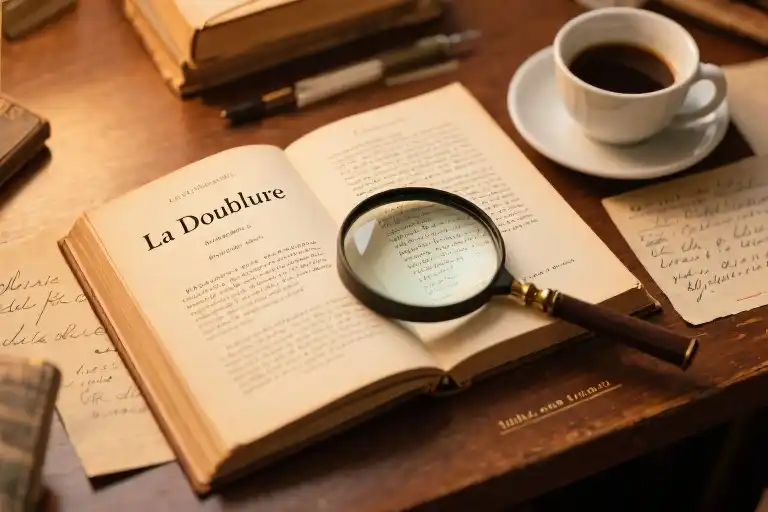There’s something irresistibly subversive about rediscovering Tolstoy when you least expect it. Like stumbling upon an old friend who somehow knows exactly what you’ve been struggling with lately. That’s precisely what happened when I pulled out my worn copy of Anna Karenina during a routine bookshelf reorganization—an act as innocuous as midnight penguin documentaries, yet equally capable of delivering unexpected revelations.
The spine cracked with that particular scent of aged paper and wisdom as I absentmindedly flipped through pages I hadn’t visited in years. Suddenly, there he was again—not just the bearded portrait on the back cover, but Tolstoy himself materializing in my living room with that knowing gaze. You know the one. That look that says, “Still checking your phone every five minutes, I see? Let’s discuss why that matters.” Classic Tolstoy—refusing to remain a historical artifact, insisting instead on being the most perceptive houseguest you never invited.
What makes revisiting Anna Karenina such a peculiar experience isn’t just its timeless themes (though those certainly persist). It’s how Tolstoy’s observational genius operates like psychological sonar—pinging back echoes of our modern anxieties through seemingly mundane details. The way Anna adjusts her gloves three times before leaving the house suddenly mirrors our own pre-Zoom meeting rituals. Levin’s existential crisis during hay-cutting season feels suspiciously like that Sunday night dread before another workweek.
And therein lies the magic trick Tolstoy performs across centuries: his ability to make six-hundred-page nineteenth-century novels feel like they’re commenting on your unread emails and social media fatigue. The agricultural reform tangents? Sure, we might skim those (even Russian literature professors admit to it). But the real treasures hide in the margins—in the twitch of a finger or an overheard conversation that reveals more about human nature than any philosophical monologue could.
Perhaps this explains why we alternately resist and crave Tolstoy’s presence in our lives. He’s the friend who points out our contradictions while making us laugh at them—if we’re willing to sit through the occasional lecture about peasant farming techniques. The key, as I’ve learned through multiple unplanned reunions with his work, is approaching these classics not as sacred texts but as living conversations. Skip the sections that lose you (he’ll never know), linger where the sentences suddenly vibrate with recognition, and always—always—pay attention to what happens between the grand dramatic moments.
Because that’s where Tolstoy waits for us. Not in the ballroom scenes or the tragic endings, but in the quiet, unguarded instants when his characters forget to perform—just like we do when no one’s watching our Instagram stories.
The Love-Hate Affair with Tolstoy
It starts with the best intentions. You pick up Anna Karenina for the third time, determined to finally conquer this literary Everest. By page 50, you’re invested in Anna’s doomed romance. By page 200, you’re mentally drafting angry letters to Vronsky. Then suddenly—bam!—you hit the 30-page detour about 19th-century Russian crop rotation, and your bookmark starts slipping toward the back cover.
This isn’t failure. This is the universal Tolstoy experience. Modern readers face three classic roadblocks when approaching these doorstopper novels:
1. The Agricultural Detour
Every Tolstoy fan develops selective reading strategies. That survey claiming “85% skip Levin’s farming chapters”? Probably underreported. These sections feel like literary speed bumps—until you realize they’re where Tolstoy hides some of his most profound meditations on happiness. The secret? Skim the wheat yields, savor the existential insights.
2. The Moralizing Tone
There’s always that moment when Tolstoy’s authorial voice breaks through like a stern professor clearing his throat. But here’s the twist: his characters constantly rebel against his judgments. Anna’s raw humanity contradicts Tolstoy’s later sermons about her sin—making the novel more complex than even its creator intended.
3. The Sheer Volume
At 800+ pages, these books demand commitment. Yet their length becomes the point—you don’t read Tolstoy so much as live inside his world until the characters feel like problematic friends you can’t quit.
Why We Keep Coming Back
Psychology explains this push-pull dynamic. Great literature creates “cognitive immersion”—that eerie sensation when fictional characters occupy mental space normally reserved for real relationships. Tolstoy mastered this through:
- Emotional precision: His descriptions of jealousy mirror actual neural pathways
- Unfinished thoughts: His characters’ interrupted dialogues mimic real speech patterns
- Embodied cognition: Physical gestures (like Anna twisting her wedding ring) reveal inner states more honestly than dialogue
So next time you guiltily skip fifty pages, remember: you’re not cheating Tolstoy—you’re reading him the way his contemporaries did. Serialized in magazines, these novels were meant for selective enjoyment. Your 21st-century attention span might be his most authentic reader yet.
The Microscope of Tolstoy: Decoding the Hidden Language of Details
What makes Tolstoy’s writing endure isn’t the sweeping historical narratives or philosophical treatises tucked between chapters—it’s the nearly imperceptible human moments he captures with forensic precision. These literary DNA strands carry emotional codes that bypass centuries, speaking directly to our modern nervous systems.
Case Study 1: Anna’s Lip-Biting Anxiety (The 19th-Century Fidget Spinner)
Notice how often Anna Arkadyevna’s teeth graze her lower lip during social interactions—a tic Tolstoy mentions seventeen times across the novel. Each occurrence maps to escalating distress:
- First appearance (Part 1, Chapter 15): A barely noticeable nibble when spotting Vronsky at the ball
- Mid-novel escalation: Visible teeth marks during strained conversations with Karenin
- Final chapters: Blood drawn during her catastrophic mental unraveling
This isn’t period-appropriate ladylike behavior; it’s a masterclass in showing anxiety through micro-behaviors. Modern equivalents? The way we:
- Refresh email every 37 seconds
- Unlock phones just to relock them
- Peel label stickers off water bottles in meetings
Tolstoy didn’t have clinical terms like ‘body-focused repetitive behaviors,’ but his observational genius created literary CBT worksheets before psychology existed as a formal discipline.
Case Study 2: Levin’s Scything Epiphany (Proto-Mindfulness Meditation)
That infamous farming passage everyone skips? Buried in the agricultural tedium (Part 3, Chapter 4) lies one of literature’s purest depictions of flow state:
“The longer he mowed, the oftener he felt those moments of oblivion during which it was not his arms which swung the scythe, but the scythe seemed to mow of itself…”
Tolstoy maps the neurological shift from conscious effort to embodied mastery—something modern wellness gurus package as:
- ‘Getting in the zone’ during workouts
- ‘Hands-free thinking’ during showers
- The ‘runner’s high’ phenomenon
That thirty-page farming detour suddenly becomes worth revisiting when read as a manual for digital detox. Who knew 1870s peasant labor could teach us about smartphone addiction?
Case Study 3: Kitty’s Skating Performance (Instagram Before Filters)
Watch how young Kitty consciously modulates her skating style when observed (Part 1, Chapter 9):
- Alone: Clumsy but joyful movements
- Under Vronsky’s gaze: Artfully controlled glides
- After rejection: Deliberately broken rhythm
This isn’t just character development—it’s a blueprint for understanding:
- LinkedIn vs. Finsta personas
- Zoom meeting posture vs. couch slouching
- The calculus behind leaving a text on ‘read’
Tolstoy reveals what social media algorithms now exploit: our perpetual self-editing for invisible audiences.
The Details That Bind Us
What connects these moments across 150 years? Tolstoy’s refusal to write ‘generic’ emotions. Every psychological state comes wrapped in:
- Specific bodily actions (not ‘she was nervous’ but ‘her glove stitches tore under clenched fingers’)
- Environmental triggers (a ringing clock tower, not an abstract ‘passing of time’)
- Physiological consequences (sour stomachs, not just ‘dread’)
This hyper-concrete approach makes his characters feel less like historical figures and more like that friend who texts you at 2AM about their existential crisis—complete with emoji-proof descriptions of their physical symptoms.
Try This: Next reread, highlight every instance of:
- Hand gestures
- Digestive reactions
- Weather interactions
You’ll uncover Tolstoy’s secret wiring diagram for human behavior—one that still powers our emotional operating systems today.
When 19th Century Anxiety Meets the iPhone Era
The Social Masks of Anna vs. Instagram Personas
Anna Karenina’s compulsive adjustment of her gloves at the ball mirrors our modern ritual of refreshing Instagram feeds – both are elaborate performances of control. Tolstoy captures that moment when Anna’s fingers fumble with her fan (Chapter 22) with the same precision we might describe someone anxiously tapping their phone screen during an awkward pause. The parallel reveals how little the core of social anxiety has changed since 1878; we’ve simply exchanged silk gloves for smartphone cases.
Consider this: Anna’s calculated entrance into Moscow society operates on the same psychological principles as crafting the perfect LinkedIn headline. Both involve:
- Curating visible attributes (her “unusually animated face” vs. profile picture filters)
- Strategic vulnerability deployment (her “trembling lips” vs. humblebrag posts)
- Constant audience assessment (those searching aristocratic eyes = modern like notifications)
Levin’s Identity Crisis and the Slash Generation Dilemma
Modern readers doing mental gymnastics between their day jobs and side hustles will find an unexpected ally in Konstantin Levin. His famous existential crisis while mowing the fields (Part 3, Chapter 12) could be a transcript from any millennial’s therapy session today. That passage where he swings between “This is meaningful labor” and “What’s the point of it all?” perfectly encapsulates the slash generation’s whiplash between passion projects and paying rent.
Tolstoy documents three phases of Levin’s breakdown that mirror contemporary burnout patterns:
- The Productivity High (“The longer he mowed, the more often he experienced those moments of oblivion”)
- The Doubt Spiral (“What am I doing this for?”)
- The Nihilistic Crash (“It’ll all be overgrown with grass again anyway”)
Replace scythe with spreadsheet, and you’ve got the 21st century version of this eternal struggle. The genius lies in how Tolstoy validates both the nobility of the search and the absurdity of our coping mechanisms – whether it’s 19th century landowners obsessing over crop rotation or modern urbanites obsessing over bullet journals.
#MyTolstoyMoment Reader Challenge
Here’s where classic literature stops being a museum exhibit and becomes a living conversation. We’re collecting real-life moments when Tolstoy’s characters suddenly felt contemporary – those instances when:
- You recognized Anna’s performative perfectionism in your own polished Zoom backgrounds
- Felt Levin’s agricultural angst while doomscrolling through #VanLife posts
- Spotted Stiva’s charming irresponsibility in that friend who’s always “between opportunities”
Try this exercise: Next time you catch yourself in a modern anxiety loop, ask: which Tolstoy character would have this same thought process? You’ll discover his psychological blueprints hidden in:
- Decision fatigue at grocery stores (Kitty choosing baby clothes)
- Midnight career panic (Levin’s 3am estate calculations)
- Social media envy (Vronsky’s cavalry comrades rivalry)
These aren’t historical artifacts – they’re diagnostic tools for understanding our own era. The true magic happens when we realize Tolstoy wasn’t writing about 19th century Russia; he was writing about the human condition with such precision that his observations time-travel effortlessly to our digital age.
Pro Tip: Keep an eye on small physical behaviors – Tolstoy’s genius often leaks through his characters’ unconscious gestures. Anna’s habit of crumpling her handkerchief would today manifest as compulsive phone unlocking; Levin’s tendency to pace would translate to restless leg syndrome during video calls. These are the timeless tells of human anxiety.
The Trouble (and Triumph) With Tolstoy: A Final Invitation
He’s still there when you close the book—that bearded nineteenth-century intruder now comfortably nested in your twenty-first-century living room, one eyebrow perpetually raised in silent challenge. Tolstoy never really leaves; he just waits patiently for you to notice how eerily familiar his characters’ anxieties feel when you’re doomscrolling through Instagram at midnight or rehearsing conversations in the shower.
Three Ways to Reclaim Tolstoy (On Your Own Terms)
- The Penguin Documentary Approach
Next time you reorganize your shelves, let your fingers linger on that intimidating classic. Read just one randomly selected page—preferably during that liminal hour when YouTube starts recommending tractor restoration videos. Like my accidental 2am penguin documentary marathon, you’ll discover fresh insights precisely because you’re reading without agenda. “When analyzing Tolstoy’s writing style,” notice how Anna’s fidgeting with her gloves mirrors your own pre-meeting nervous habits. - Surgical Skip-Reading
Give yourself full permission to bypass the agricultural treatises (we’ve all done it). Instead, hunt for these three underrated moments that reveal “why Tolstoy is still relevant”:
- The way Levin’s hay-cutting trance mirrors modern mindfulness apps
- Kitty’s flushed cheeks during the ice-skating scene—a Victorian-era Instagram blush filter
- That single paragraph where Anna absentmindedly destroys a hotel notepad—ancient ancestor of stress-clicking your pen during Zoom calls
- #TolstoyMadeMeDoIt Journaling
When classic literature suddenly collides with your reality—maybe you catch yourself judging a stranger’s outfit exactly like Stiva Oblonsky, or realize your dating app bio sounds suspiciously like Vronsky’s cavalry charm—snap a photo and tag it. These aren’t academic observations; they’re proof that “classic literature for modern readers” works best when treated like a mischievous friend who keeps pointing out your blind spots.
Your Turn Now
That eyebrow-arching ghost on your couch? He’s not here to test your literary credentials. Tolstoy’s real magic happens when we stop treating classics like museum pieces and start recognizing them as mirrors—slightly foggy, yes, but still reflecting our own messy humanity with startling clarity.
So go ahead: dog-ear pages guiltlessly, laugh when the characters remind you of your group chat, and share your #TolstoyMadeMeDoIt moments. After all, the trouble with Tolstoy is also his greatest gift—he makes centuries collapse like a well-folded love note in your back pocket, always ready to surprise you when you least expect it.





